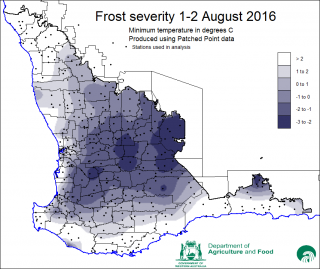Growers are reminded to check crops for symptoms of frost damage, following frost events across parts of the Wheatbelt, Great Southern and Lakes Districts.
Department of Agriculture and Food research officer Ben Biddulph said there had been several frost events in the region during the past fortnight which could result in minor impacts on crops.
"Growers in these areas should be alert to the impact of the frost," Dr Biddulph, who is Management Program leader for the Grains Research and Development Corporation (GRDC) National Frost Initiative, said.
"Growers should be looking for symptoms of damage in crops which will become visible over the next week. When damage is clear, management and salvage options can be considered carefully."
Frost symptoms may not be obvious for up to 10 days after a frost event. The damage tends to be patchy and variable within a paddock.
Dr Biddulph said early sown crops, low lying areas and light coloured soil types were usually most at risk and these areas should be checked first.
"Growers must be confident about damage levels and consider a range of economic aspects before making decisions about damaged crops," he said.
Department and Bureau of Meteorology weather stations show some localised areas recorded temperatures as low as -2 to -4ºC that will result in frost damage, most from the nights between 1 to 2 August in the central, eastern and Upper Great Southern agricultural region, including Quairading, Bonnie Rock, Narembeen, Hyden, York, Beverley, Wickepin and Narrogin.
In some of these areas, which experienced rain during the evening beforehand, there have been localised reports of stem and reproductive frost damage in canola, wheat, barley and lupin crops at susceptible stages, in susceptible parts of the landscape and soil types.
"These symptoms are visible now and should be monitored over the next fortnight," Dr Biddulph said.
A series of milder frosts with minimum temperatures of -1 to -2ºC also occurred in agricultural areas in the northern Wheatbelt, Lower Great Southern, Lakes Districts and Salmon Gums.
Detailed information on identifying frost damage and evaluating options for frost affected crops is available from the department website.
Growers are encouraged to discuss management options with their local consultants.
Report frost damage through Pestfax Reporter App available on Apple App store, Google play or on the department website.
Dr Biddulph leads and is involved in several current GRDC-funded national frost projects DAW00241, DAW00234 and UA00162.

Media contacts: Jodie Thomson/Megan Broad, media liaison +61 (0)8 9368 3937
